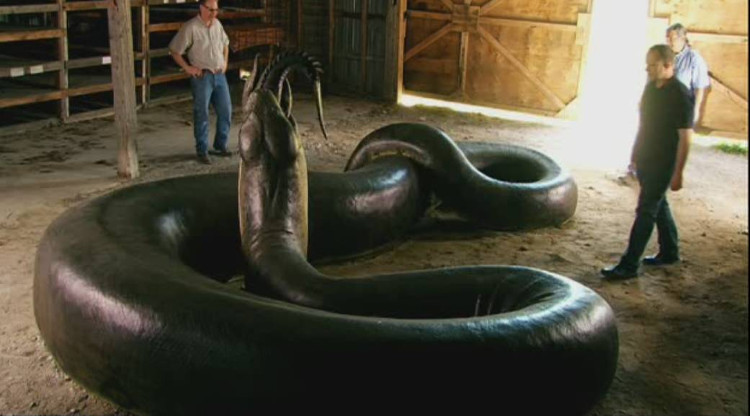Ancient mangoes weigh more than a ton of crocodile meat
The huge size and weight of the ancient Titanoboa snake makes it easy to squeeze crocodiles to eat meat.
The full-size version of the giant snake with a scientific name is on display at the Life Science Museum Monte L. Bean at Brigham Young University, Utah, USA, Washington Post on January 6.
Reconstructing a battle between Titanoboa and T-Rex tyrant dinosaur.(Video: Smithsonian Channel).
Titanoboa is 14.6 meters long, lives in the jungle 60 million years ago and specializes in hunting crocodiles to eat meat. This animal does not kill with fangs or venom, but uses extremely strong muscles on the body that weigh more than one ton to kill its prey.
Researchers found Titanoboa's fossil at a coal mine in Colombia, which kept many traces of animals living in the hot and humid tropical rainforest that covered the Earth during the Old Earth, period Dinosaurs began to become extinct.

The true size model of Titanoboa is swallowing a crocodile.(Photo: Smithsonia).
Titanoboa is really big with a body longer than a bus. According to scientists, if confronted directly, Titanoboa's " hardy " can hardly win against the T-Rex tyrant dinosaur, but if suddenly ambushed, this ancient snake could kill even the giants. the most aggressive.
The real-size version of this ancient monster, borrowed from the Museum of Monte L. Bean from the Smithsonia Institute, serves the "Titanoboa Snake Monster" exhibition .
- Ancient crocodile monsters weigh three tons living under the sea
- Crocodile eat dinosaur meat
- New discovery: Crocodile crawling trees
- Mysterious ancient crocodile bones found in ancient desert in Israel
- Detecting ancient crocodiles 11 meters long
- Ancient crocodiles ever clever like dolphins?
- Jura crocodile sharp teeth like tyrants
- Jurassic fossils reveal a new long muzzle crocodile
- Close up of fossils of crocodiles, elephants, giant prehistoric birds
- Lolong crocodile made 'Ambassador' for conservation program
- Video: 4m long crocodile devoured its kind
- Finding fossils of ancient vegetarian crocodile strains
 Discovered an ancient centipede fossil 99 million years old
Discovered an ancient centipede fossil 99 million years old Discovered bat-like dinosaurs in China
Discovered bat-like dinosaurs in China Discovered a 200-year-old bronze cannon of the coast
Discovered a 200-year-old bronze cannon of the coast Discover 305 million-year-old spider fossils
Discover 305 million-year-old spider fossils